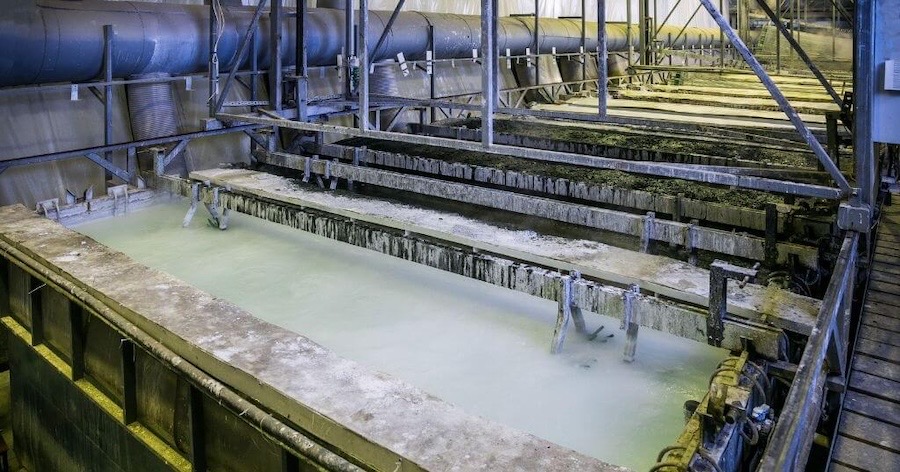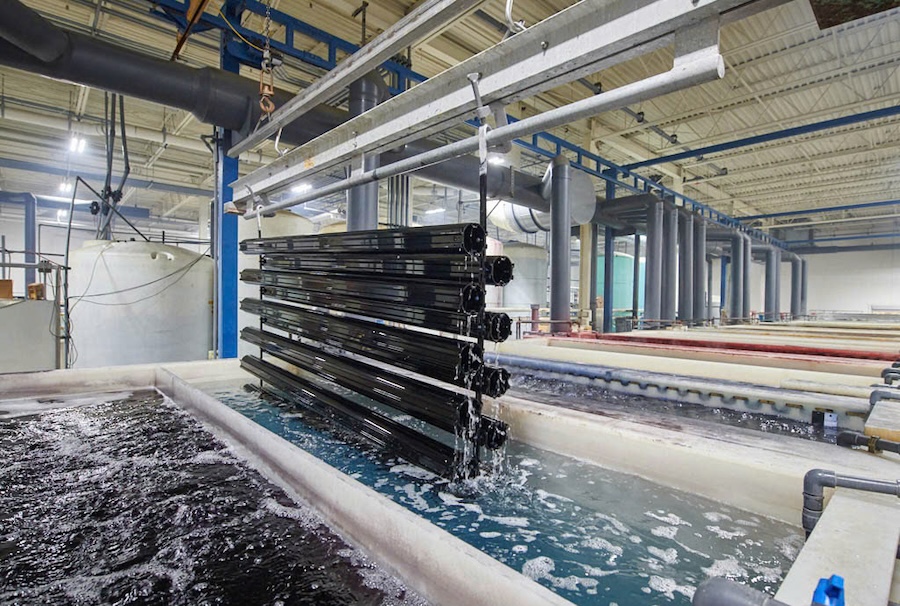In the context of rapid industrial development, electroplating is one of the key industries, contributing to enhancing the durability and corrosion resistance of metal products. However, alongside its economic benefits, this process also generates a large volume of wastewater containing harmful chemicals and heavy metals such as Cr⁶⁺, Ni²⁺, Zn²⁺, which pose significant pollution risks if not properly treated. Therefore, wastewater treatment in electroplating is not only a technical requirement but also a legal obligation for every business in this sector.
1. Characteristics of Electroplating Wastewater
Electroplating wastewater primarily arises during production stages such as: degreasing, rust removal, electroplating, post-plating washing, etc. The composition of the wastewater is complex and varies depending on the electroplating technology used:
-
Heavy metals: Cr⁶⁺, Ni²⁺, Cu²⁺, Zn²⁺, Cd²⁺, etc., with high concentrations and poor biodegradability.
-
Acid and base solutions: H₂SO₄, HCl, NaOH, which cause significant pH fluctuations.
-
Surfactants, organic solvents, and complexing agents.
-
TDS and high electrical conductivity, affecting traditional biological treatment processes.
These characteristics make electroplating wastewater treatment challenging and require the design of specialized systems and the application of suitable technologies.

Electroplating systems in factories discharge wastewater containing high concentrations of heavy metals that require thorough treatment
2. Effective Electroplating Wastewater Treatment Methods
Depending on the flow rate, pollutant concentration, and specific characteristics of the wastewater, businesses can choose one or combine several of the following technologies:
2.1 Electrochemical Method
Electrochemistry is an advanced treatment method that uses direct current to promote oxidation-reduction reactions, helping to remove heavy metals from wastewater:
-
Anode: Typically made from lead oxide or graphite.
-
Cathode: Uses molybdenum or alloys containing iron and nickel.
When the current passes through, metal ions are reduced and precipitate into an insoluble form, making them easy to remove. This method is suitable for treating electroplating wastewater with high metal concentrations. However, the investment cost for equipment and electricity consumption must also be considered.
2.2 Chemical Precipitation
This is a traditional and common method for treating electroplating wastewater:
-
pH Adjustment: Sodium hydroxide (NaOH) or lime is typically used to increase pH, allowing metals to precipitate as hydroxides.
-
Addition of Precipitating Agents: Such as sulfides (Na₂S) to remove metals that are difficult to precipitate through conventional methods.
The advantages are low cost, easy operation, and high efficiency in removing most heavy metals. However, the large volume of sludge generated requires further treatment.
2.3 Adsorption
The adsorption method uses materials capable of retaining metal ions and pollutants:
-
Activated Carbon: Effectively adsorbs organic compounds and some metal ions.
-
Synthetic or Biological Materials: Such as zeolites, alumina, and biological materials made from yeast, rice husks, and biochar.
This method is typically used as a final treatment step to reduce remaining pollutant concentrations, ensuring that treated wastewater meets regulatory standards.

Overview of the Most Common Electroplating Wastewater Treatment Methods in Use Today
2.4 Biological Treatment
Although not the primary method for treating electroplating wastewater, biological treatment still plays an important role when the wastewater contains organic substances (e.g., grease, detergents):
-
Aerobic tanks: Microorganisms break down organic matter into CO₂ and H₂O.
-
Biological filters: Utilize media embedded with microbes to enhance treatment efficiency.
Combining physicochemical and biological methods is a growing trend to optimize both cost and performance.
3. Discharge Standards and Legal Regulations
According to QCVN 40:2011/BTNMT – Vietnam’s National Technical Regulation on Industrial Wastewater, wastewater from electroplating activities must be treated to meet discharge standards before being released into the environment. Some key limits (Column A) include:
-
pH: 6.0 – 9.0
-
Total Chromium (Cr): ≤ 0.2 mg/L
-
Nickel (Ni): ≤ 0.1 mg/L
-
Zinc (Zn): ≤ 0.5 mg/L
-
TSS (Total Suspended Solids): ≤ 50 mg/L
-
COD (Chemical Oxygen Demand): ≤ 75 mg/L
Businesses are required to invest in qualified electroplating wastewater treatment systems. Exceeding discharge limits may result in penalties, suspension of operations, or even criminal liability under Vietnamese law.
4. Why Choose Dai Nam as Your Electroplating Wastewater Treatment Partner
Dai Nam Environmental Solutions Co., Ltd. is a leading company in the environmental sector, particularly in electroplating wastewater treatment. With over 10 years of experience, a team of highly skilled engineers, and a nationwide project footprint, we are committed to:
-
Tailored consulting and system design based on each business’s specific needs
-
High treatment efficiency that meets QCVN Column A or B standards as required
-
Optimized operational costs, reduced chemical use, and minimized sludge generation
-
Full support for legal documentation, EIA (Environmental Impact Assessment), trial operation, and final acceptance
-
Long-term warranty and 24/7 technical support
Projects Implemented by Dai Nam Ensure Full Legal Compliance and Environmental Safety
The electroplating wastewater treatment systems implemented by Dai Nam are always efficient, stable in operation, and environmentally friendly. That’s why hundreds of businesses have chosen us as their long-term partner in the field of wastewater treatment.


